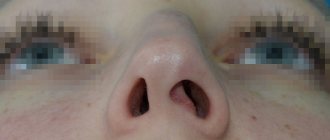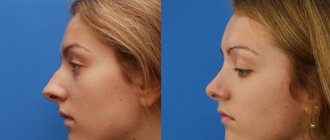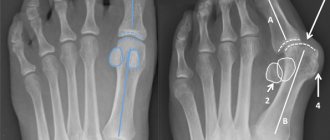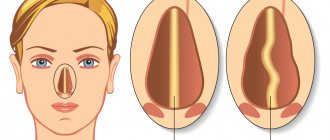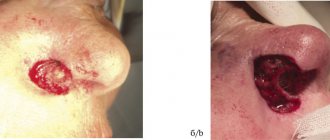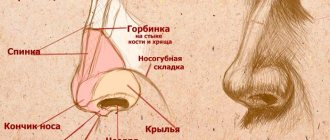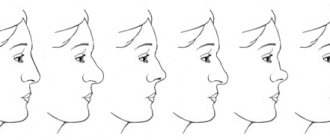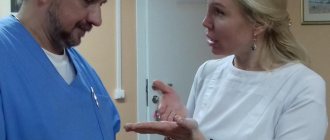Fracture of the bones and cartilage of the nose is one of the most common human injuries. Half of all cases of damage to the facial part of the skull occur due to a fracture of the nose, which is, in principle, predictable, since the nose is the most protruding part of the face. Therefore, a seemingly minor bruise can provoke bone displacement. This condition is unpleasant not only from an aesthetic point of view, but also from the point of view of its effect on the sense of smell and our nasal breathing.
Such injuries can be the result of sports (for example, boxing or wrestling), road traffic accidents, impacts, or careless play by children. There are a lot of reasons. But despite its prevalence, such damage can cause serious consequences, so you should not delay medical help.
Repositioning the nose is called repositioning the nasal bones. Patients have a lot of questions about this procedure: “At what point should reposition be carried out?”, “How painful is it to reduce the fracture of these bones”?, “How long does recovery after surgery last?” We will answer all these questions in our new article.
Signs of a fracture
The cartilaginous skeleton of the nose consists of the lateral, a pair of large and small cartilages and the cartilage of the nasal septum. All of them are quite fragile and easily injured. The first signs of a fracture directly depend on the nature of the damage, as well as under what circumstances and how it was caused.
The main symptom of damage is bone deformation and displacement of the nasal bridge. If the damage is minor, there may be no visible signs of bone displacement. If the cartilage is damaged, the integrity of the bones may not be compromised. In these cases, the presence of a fracture is determined using x-ray or computed tomography.
If, when palpating the nose, characteristic crunching sounds are made (crepitus of bone fragments), then there is definitely a fracture. But this does not mean that you need to immediately feel, press on the nose and carry out any mechanical actions with it yourself in order to recognize the sounds of bone rubbing against bone. Only an ENT doctor should carry out such manipulations, otherwise the situation can worsen.
Standard symptoms of injury are swelling of the nose and area around it, swelling, bruising, and nosebleeds. When pressing on the site of the bruise, the patient feels a sharp pain. Bloody streaks may appear in the eyeballs, and copious discharge of mucous masses from the nasal passages.
Rehabilitation after a broken foot
Often people do not go to the doctor when they have foot injuries. Such a neglectful attitude towards one’s health is unacceptable, even in cases where there is no pain. It is imperative to visit a surgeon or orthopedist, because even the absence of a fracture is not a guarantee that everything will be fine in the future. Foot injuries can be of various types. In each specific case, a specific type of diagnosis and therapeutic treatment is selected. During the diagnostic process, an examination of the foot and ankle is performed, as well as an x-ray. Equally important is rehabilitation after a broken foot and other injuries. Most people who lead an active lifestyle are primarily interested in the duration of treatment. On average, recovery of injured foot bones occurs within a month. But to achieve a positive result, a serious approach to treatment is required. The recovery process also depends on the following factors:
- person's age;
- the nature of the injury to the bones of the foot;
- general health of the patient (presence of other diseases);
- strength of the body's defenses (immunity).
Rehabilitation after an injury may take additional time.
A foot fracture is a very painful injury, and its effects are often felt many weeks after the cast is removed. In order to completely get rid of them, it is necessary to regularly conduct physical therapy sessions, preferably under the guidance of a doctor. The patient will also need the services of a massage therapist and physiotherapist. Rehabilitation after fractures of the foot bones is greatly helped by wearing orthopedic shoes or inserting orthopedic insoles into regular shoes. Sometimes significant improvement occurs only a year after the injury.
Types of fractures
Like any other, a nasal fracture can be open or closed. An open fracture is accompanied by a violation of the integrity of the skin, that is, an open laceration forms at the site of injury. It happens that the patient even sees bone fragments through it.
In the case of a closed fracture, a violation of the integrity of the bone is not accompanied by a violation of the integrity of the skin over the fracture area. But with such damage, hematomas and bruises may occur.
Both injuries can be accompanied by displacement—visible deformation of the nasal wall.
In both cases, you should immediately seek medical help. If in the second case the patient can go to the doctor on his own, then with an open injury the person cannot move, so it is necessary to call an ambulance.
Rehabilitation after a broken bone
The Baltiyskiy Rehabilitation Center provides rehabilitation after bone fractures for all patients who have reached adulthood. The center is equipped with all the necessary equipment and employs highly professional, experienced rehabilitation doctors. All patients are on full board; relatives will not have to purchase additional medications or food. The rehabilitation facility has all the conditions for patients of any age. Correctly carried out rehabilitation for a bone fracture ensures complete restoration of the motor functions of the damaged organ and the resumption of a full, healthy life. The rehabilitation process includes a whole range of procedures that must be carried out over a certain period. Lost time can play a negative role in the patient’s recovery. Therefore, we recommend that everyone in need of rehabilitation after bone fractures contact a rehabilitation center immediately after being discharged home from the hospital.
First aid
Before arriving or visiting a doctor, the patient must be given first aid. To begin with, he needs to be seated so that his head is slightly tilted forward, so that blood from the nasal cavity will not flow into the respiratory tract. Blood clots must be removed very carefully from the area of injury. If cuts are visible, they should be treated with an antiseptic, for example, hydrogen peroxide, Chlorhexidine or Miramistin. Then apply cold to the site of the bruise - this will help reduce swelling and reduce the amount of bleeding.
Trying to set the bones yourself is strictly prohibited!!! It won't work for sure!!! You don't even have to try!!! Lack of necessary knowledge, as well as inept actions can lead to disruption of normal nasal breathing. Do not forget also that the reduction process is quite painful and is not carried out without anesthesia, so as not to cause traumatic shock in the patient. Among other things, you need special tools, good light, a comfortable position for the patient and adequate anesthesia!
Only a doctor should perform repositioning of the nasal bones!
Rehabilitation after a broken leg bone
A shin fracture is an injury, recovery from which is long and difficult.
Basic procedures during rehabilitation:
- Physiotherapy
- Massage sessions
- Specially Designated Exercises
- Therapeutic and preventive diet
Rehabilitation after a tibia fracture is primarily intended to eliminate degenerative changes in soft and hard tissues located in the area of injury. It is necessary to restore the functions of the joint and eliminate congestion. For this purpose, it is worth using massage, physiotherapeutic procedures, exercise therapy, as well as the Ilizarov apparatus. When the cast is removed from the lower leg, the first stage of rehabilitation is to restore leg movement and eliminate swelling. At this time, it is necessary to develop the damaged limb. Physiotherapy and massage promote good circulation, and therapeutic exercises are aimed at keeping the leg in normal shape. During this difficult period, it is recommended to walk as much as a person can. It is also very useful to make rotational movements in the ankle joint, roll from heel to toe and vice versa, and it is good to do the “scissors” exercise. The most important thing is to perform a cycle of these loads daily. And don’t overload yourself, that is, know when to stop. As for nutrition, it should contain enough vitamins and nutrients, thanks to which the human body can feel good and recover quickly. Cottage cheese, milk, cabbage, currants, bran, beef, fish are foods that promote complete and rapid healing of damaged tissue. In some cases, the patient needs the help of a psychologist. After all, it happens that after an injury a person develops a fear of possible repeated fractures, as a result of which there is no desire to develop the leg. You need to understand that morale is very important, and do everything possible to make it positive.
The complexity and duration of recovery of the lower leg after a fracture directly depends on the complexity of the fracture itself, as well as the general health of the patient, his age and concomitant diseases and injuries. During rehabilitation after a fracture of the leg bones, the doctor strives to increase the tone of the leg muscles, improve their blood supply and prevent atrophy, not lose mobility in the joints and, ultimately, restore the active functioning of the damaged limb. If the patient carefully follows all the doctor’s instructions, this is usually possible.
What are the risks of a broken nose?
Damage to the nose can lead to serious consequences for human health:
- nosebleeds;
- concussions of varying severity;
- damage to the nasolacrimal duct;
- impaired sense of smell, inability to distinguish odors (hyposmia and anosmia);
- frequent sinusitis and inflammation of other paranasal sinuses (frontitis, ethmoiditis, sphenoiditis);
- proliferation of the inferior turbinates (hypertrophic and vasomotor rhinitis), as a result, severe difficulty in nasal breathing;
- persistent ear congestion (eustacheitis, tubootitis, adhesive otitis media), which makes it difficult for a person to communicate normally with others;
- painful flow of mucus through the nasopharynx due to the involvement of the posterior ends of the inferior turbinates in the inflammatory process;
- deformation of the nasal septum, which can lead to disruption of normal breathing through the nose. Impaired breathing provokes frequent exacerbations of chronic rhinitis, the patient is more often exposed to viral attacks, and cases of acute respiratory viral infections are becoming more frequent;
- the appearance of an invisible hematoma of the nasal septum, which can lead to suppuration and melting of the nasal cartilage;
- blood poisoning through a wound. The paranasal sinuses are located near the fracture site. An inflammatory process can start in them, which can subsequently spread to the membranes of the brain;
- aesthetic effect - the displacement changes the appearance of the nose, distorting the person’s face.
Rhinoplasty of nasal hump
In case of incorrect actions after a nose fracture, a hump may form after a certain time. It is also possible to get rid of this nasal deformity during surgery to correct the consequences of a fracture.
Attention! Even if you had a hump or crooked nose before the fracture, it can be corrected during surgery. Discuss all the details with the operating doctor, and perhaps you will immediately correct all the imperfections of the nose.
The operation is performed under general anesthesia and lasts up to three hours. Hump rhinoplasty is performed as follows:
- First of all, the doctor cuts the skin on the inner surface of the wings of the nose:
- then the hump itself is removed;
- the position of the bones and volume in this area are corrected;
- stitches and a bandage are applied, and turundas are placed in the nostrils.
Please note that this correction may make your nose appear longer.
Therefore, additional correction of the tip of the nose is possible, thus:
- access to cartilage tissue is provided;
- certain lobes are excised;
- if necessary, install a support;
- cartilages are sewn together;
- a cosmetic suture is applied
Reposition: indications and contraindications
The operation is prescribed for any damage if there is a displacement of the bones: retraction of the nasal bridge, the appearance of a hump on the nose, pressing of the nasal bridge inward, displacement of the bones to one side or the other, frequent nosebleeds, deformation of the nasal septum.
Reposition of the nasal bones after a nasal injury should be carried out on the first day (up to 5 days from the moment of injury). Some otorhinolaryngologists, when visiting a patient immediately after an injury, refuse to perform surgery, arguing that the surgery cannot be performed due to severe swelling. This is mistake! Repositioning is not only possible, but necessary! The operation must be done before the bones begin to grow together. Ten days after the injury, a callus begins to form, which significantly complicates the intervention and makes the procedure more painful, and after a while impossible. But even in this case, the operation is carried out. If you do nothing at all, the bones will heal incorrectly, and a more serious and expensive plastic surgery will be required - rhinoplasty, or rhinoseptoplasty.
Contraindications to emergency reduction are:
- exacerbation of inflammatory processes in the area of the facial skeleton (sinusitis, otitis);
- presence of polyps;
- poor blood clotting;
- herpes;
- colds,
- epilepsy;
- hysterical personality type;
- psychosomatic diseases;
- persistent intolerance to anesthesia.
In all other cases, intervention is permitted. If there is at least one of the described signs, the operation must be performed only in a hospital, in an operating room, with the possibility of transferring the patient to the intensive care ward.
Rehabilitation after a clavicle fracture
A clavicle fracture is a very common problem among many young people. Among the causes of this problem, one should mainly highlight direct physical impact, that is, a fall on the collarbone. If such a problem arises, it is very important to start treatment as quickly as possible and not delay it, since any delay can lead to a number of problems that will be very problematic to solve in the future.
Timely treatment, as well as well-planned recovery after a clavicle fracture, will minimize the recovery time after the fracture. However, it is quite difficult to say the exact period of rehabilitation after a collarbone fracture, since it largely depends on the age of the injured person, as well as on the degree of damage.
To give approximate figures, in the case of a child, the healing period is usually 3-4 weeks, in adolescents it is approximately 6-8 weeks, while for an adult this period is 8-10 weeks.
The main elements of exercise therapy and the main stages of clavicle restoration
Very often, the rehabilitation period after surgery includes massage and exercise therapy, which allows you to speed up the recovery time of the damaged collarbone. When performing massage and exercise therapy, you should pay maximum attention to the doctor’s recommendations, otherwise not entirely pleasant incidents may occur that can significantly increase the recovery period.
Three main stages:
- First stage. The development of the collarbone usually begins a day after the fracture and occurs without removing the fixing bandage (about 2-3 weeks, 4-5 times a day). At this stage, simple exercises are performed with spreading the fingers of the injured hand, rotating the hand, snapping the fingers, etc. If painful sensations appear, then the exercises should be stopped.
- At the second stage, after 15-20 days and after X-ray confirmation of the formation of bone callus, the splint is removed and the development of the shoulder begins. Exercises include arm abductions, exercises with a gymnastic stick, etc. The duration of the second stage of clavicle restoration requires about 15 - 20 days, depending on the severity of the fracture and the age of the victim.
- The final third stage is necessary for complete restoration of mobility and has no time limit. At this stage, auxiliary equipment, a Swedish ladder and a healing ball are widely used.
Injuries such as a broken collarbone most often occur in young people who play sports. Therefore, during the rehabilitation period after a collarbone fracture, the doctor should try to ensure that his young active patient does not harm himself with too active movements. As a rule, such fractures heal relatively quickly - within a few weeks. However, if you neglect physical therapy exercises and do not use massage during rehabilitation, the consequences of this injury will manifest themselves for many months.
Preparing for surgery
The reduction is carried out by an otorhinolaryngologist. Before starting the operation, the ENT doctor makes preoperative preparations. The ENT doctor recommends that the patient take an anesthetic and treats the surgical field with an alcohol antiseptic.
Then the ENT doctor performs anesthesia - injecting painkillers into the nasal cavity. As a rule, the operation is performed under local anesthesia. General anesthesia is used for a fractured nasal septum or if more than ten days have passed since the injury. The operation itself is carried out using special instruments - Volkov elevators. The elevator is inserted into the nasal passage, and the ENT doctor uses his fingers to realign the displaced bone, returning it to its original position.
If you do not contact immediately after injury
Failure to visit a doctor on time will result in the bone healing incorrectly in a fairly short time. And her situation will have to be corrected only in six months. This is done through surgery. First, the bone is broken, then placed in the correct position, ensuring normal fusion. This process is more complex than reducing a fresh fracture.
- Pain in the Foot After a Fracture: Causes + Remedies
And all the time before the operation, the patient will have to see in the mirror a nose that has shifted to the side or a dent or hump that has formed on it. But the main consequence of an untreated fracture is breathing problems. They can appear even if there are no external signs of the trauma.
We recommend reading about correcting a deviated nasal septum using rhinoplasty and septoplasty. You will learn about the causes and types of deformation, their diagnosis, the need for correction, preparation and implementation of procedures, and their features. And here is more information about rehabilitation after rhinoplasty.
Types of reposition and methods of implementation
The type of reposition and tactics for its implementation are chosen by the ENT doctor based on the nature and severity of the injury.
If the fracture is open, the doctor first treats the wound with hydrogen peroxide or another antiseptic. Then he administers anesthesia and performs the operation itself, inserting bone fragments into place. If there is no inflammation, the doctor applies stitches. If there is pus or contamination in the wound, then the wound is not temporarily sutured and is treated with open access, in order to better sanitation of the wound. After surgery for an open fracture, the patient is prescribed a course of antibiotics and the use of regenerating ointments and antiseptic drugs.
Closed reduction is most often performed manually using local anesthesia. It happens that a couple of skillful movements with your fingers are enough for the bones to fall into place. If displacement occurs, the ENT doctor uses elevators. Afterwards, special tight cotton swabs are inserted into the nasal passages, fixing the bones and providing a reliable frame from the inside.
In certain cases, with severe deviation and mobility, a special plaster cast is applied to the wings of the nose to prevent displacement of the bones, as well as to speed up the process of their fusion. This plaster cast is worn for one to two weeks. It is noteworthy that as the swelling subsides, the bandage begins to “dangle” on the face, and it needs to be replaced with a new one, giving it new shapes.
Usually, after the operation, the patient is sent home. Observation in a hospital is prescribed if the bleeding does not stop or in case of very severe fractures.
What happens if the application is late?
The first danger that threatens in the absence of medical care for a fracture is improper healing of the bone. The next nose correction is possible only after 6 months. This is a complex surgical operation in which the bone must be broken and then fixed in the desired position.
Important! This procedure is much more difficult and painful than timely realignment of the nose!
Moreover, until the correction can be carried out, you will experience aesthetic inconvenience. An incorrectly healed fracture leads to the formation of a dent, a hump, or a displacement of the nose to one side. It is very important that even in the absence of visual disturbances in the nose, you may experience difficulty breathing if you have a fracture.


